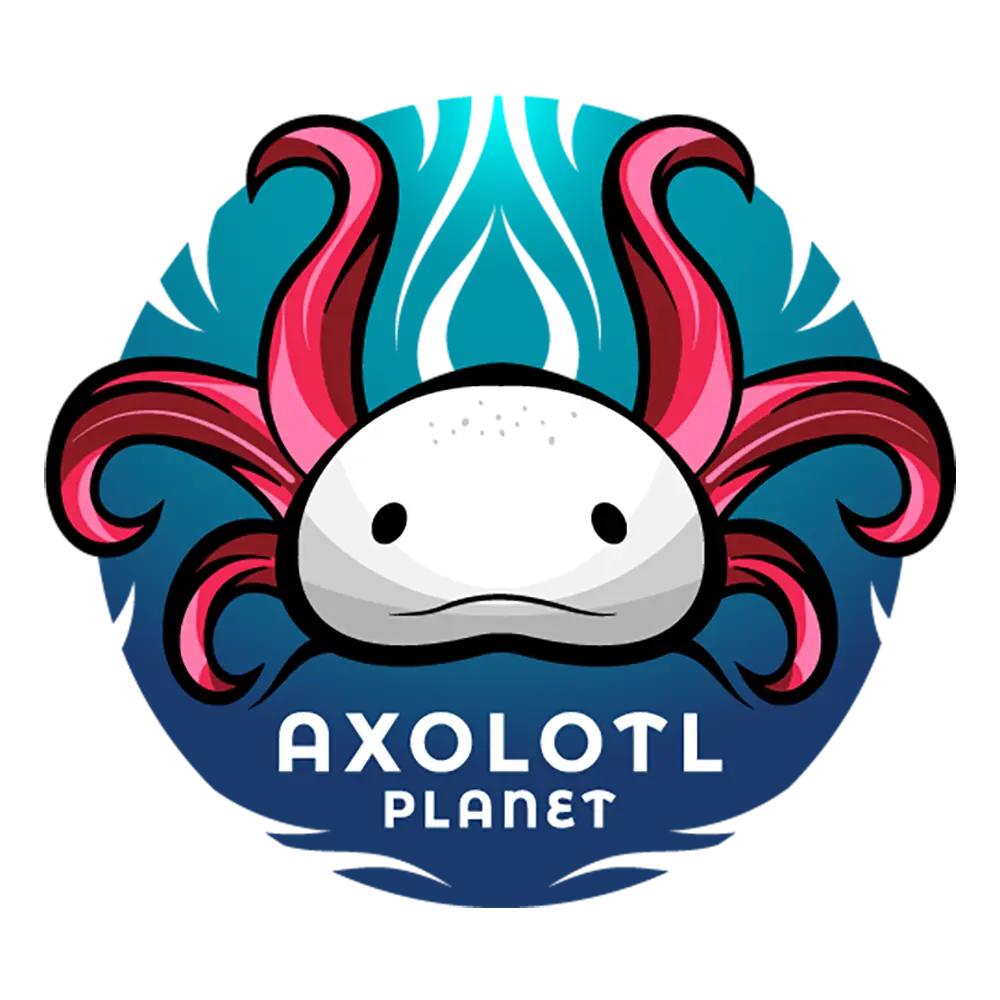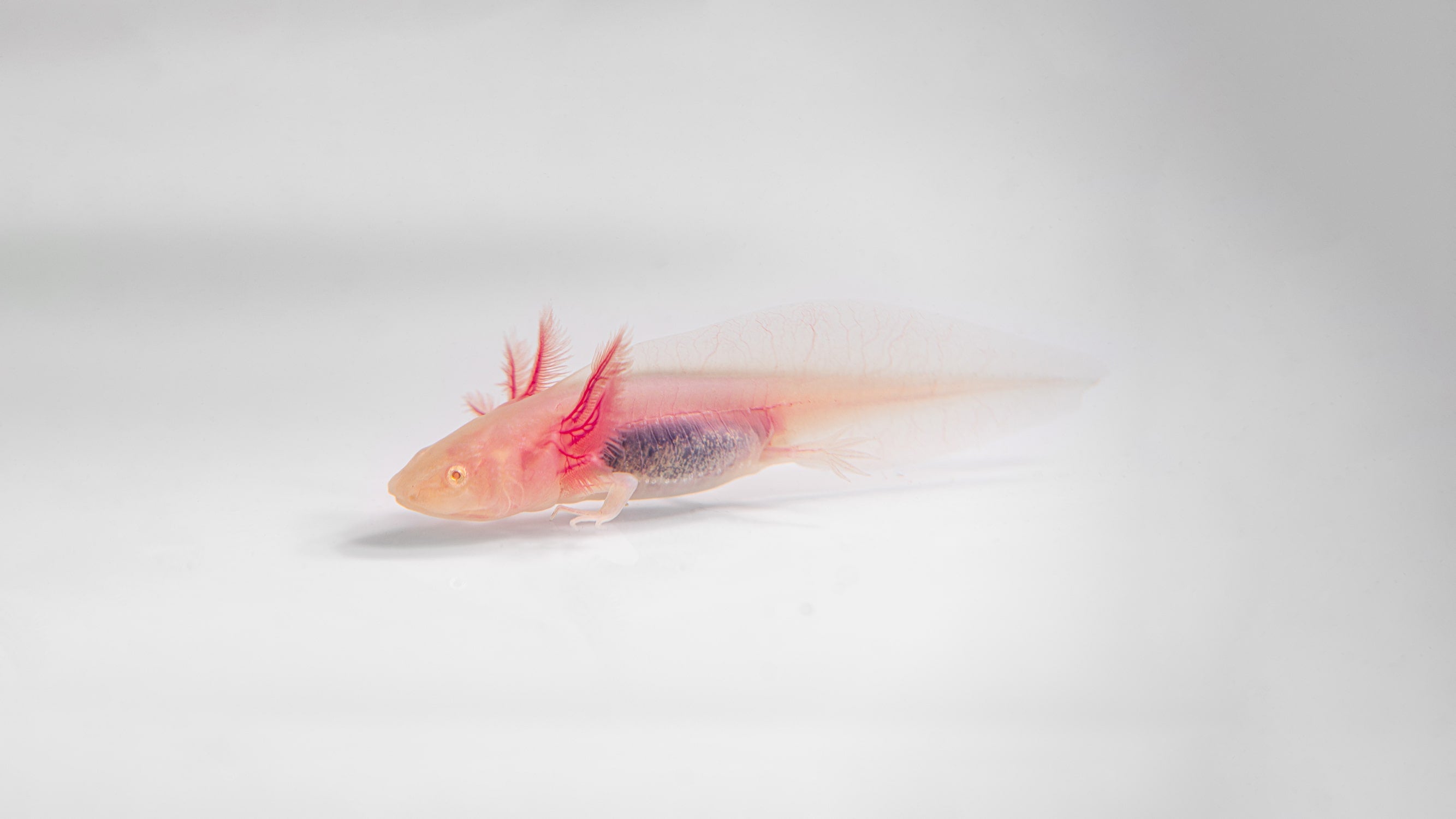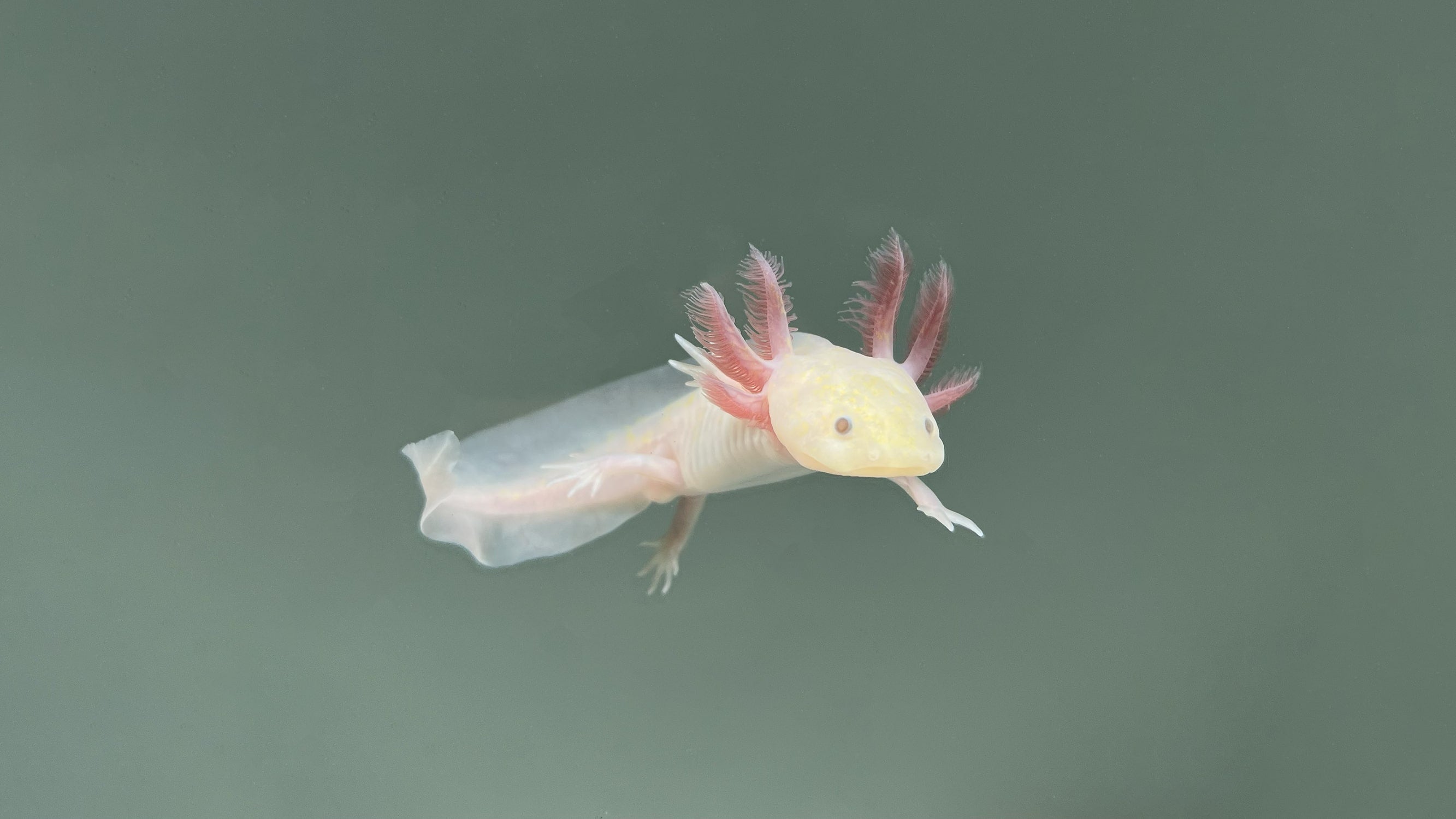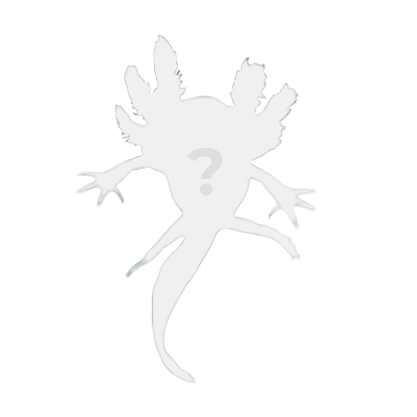Introduction
Caring for axolotls is quite easy, if you know what you’re doing beforehand. Before you purchase your first axolotl, it’s essential that you have a few things prepared ahead of time for your pet. In this article, you will learn step by step how to set up a brand new axolotl tank, establish a Nitrogen Cycle, and prepare a home for your new aquatic companion.
What Does it Mean to “Cycle” Your Tank?
If you were to study a body of freshwater like a lake or pond, you would most likely find hundreds of different kinds of animals living there. Fish, frogs, snails, and many other species call these environments home.
However, there are other residents of these freshwater locales that are so small, you can’t even see them. Millions of microscopic bacteria live in the water too! Don’t worry, these aren’t the type of bacteria that will make you sick. Instead, these are good bacteria that eat the waste and other decaying organic material floating in the water and recycle it to keep the water healthy for the other animals to live in.
This process is called the “Nitrogen Cycle.” It is simply the conversion of waste and ammonia in the water into chemicals called nitrites, and then into chemicals called nitrates. “Cycling” your axolotl tank means treating the water in your aquarium so that those same healthy bacteria that live in lakes and ponds will be able to grow.
As you feed your axolotl, its waste will cause the ammonia levels in the water to increase. If the ammonia levels get too high, it can be toxic to your animal. However, if you have a properly cycled tank, the healthy bacteria will break down the ammonia and keep the water clean and safe for your pet.
In this guide there are two cycling methods! Method 1 is heavily dependent on your ability to acquire pre-seeded media or a seeded sponge filter. This method is geared towards experienced aquarium hobbyists. Method 2 will teach you how to cycle a tank from scratch specifically for an axolotl. This method is geared towards beginners who have never had aquariums before and we highly recommend all first time axolotl owners to follow this method.
What Are the Ideal Water Parameters for My Axolotl?
Maintaining good water quality and chemical parameters in your axolotl’s habitat is essential for keeping your animal happy and healthy. These parameters are very easy to test using a freshwater test kit, which you can purchase online or from your local Petco, PetSmart, or fish store. For this purpose, we recommend using the Freshwater Master Test Kit by API. Simply follow the instructions on the kit and you’ll be able to test your water in minutes.
- pH – Ideal: 7.4-7.6 | Acceptable: 6.5-8.0
- Ammonia – 0 parts per million
- Nitrates (NO3) – Between 5 and 20 parts per million
- Nitrites (NO2) – 0 parts per million
- Temperature – 60–68°F; no higher than 72°F
How Long Does it Take to Cycle an Aquarium for an Axolotl?
Bacteria grows slowly and axolotls produce a lot of waste that needs to be dealt with so they don't get sick and possibly die. If you are cycling a brand new tank from scratch with no access to seeded media it can take anywhere from 4 to 12 weeks. If you run into a stalled cycle it can take much longer. It is essential that cycling your tank is done before purchasing an axolotl! If you are able to get access to seeded media or a seeded filter, the length of time it takes to cycle an aquarium can be significantly reduced.
Cycling Your Aquarium
There are several ways to properly cycle your aquarium. Some methods work quicker, while others take more time. In our experience cycling hundreds of aquariums for our axolotls, there are two methods that have worked best for us: Instant Cycling and Fishless Cycling.
Method 1: Instant Cycling
Summary
Instant cycling is by far the fastest, easiest, and most efficient way to establish a healthy Nitrogen Cycle in a brand new aquarium. In the event you receive an axolotl and still do not have a cycled aquarium, this method can work. Despite its name, the Instant cycling process can take up to two to four weeks to complete. This method is also dependent on your ability to acquire seeded media. If you cannot find seeded media, you will need to follow Method 2 instead and tub your axolotl until the tank is cycled. You can learn more about tubbing in our guide on How To Tub An Axolotl!
Materials
Aquarium
- 20 Gallon Long – Minimum size for juvenile and sub-adult axolotls
- 30-40 Gallon Breeder – Minimum size for adult axolotls
NOTE: Many sources online will claim that a 20 Gallon Long is an acceptable size for an adult axolotl. However, axolotls can grow to lengths of 12 inches or more! Since a 20 Gallon Long tank measures only 12 inches from front to back, larger adult axolotls will be unable to move freely in their habitat, which can cause them stress and other health problems. The more space you can provide for your pet, the happier and healthier they will be!
Filtration
There are many different filtration systems available for your aquarium, and although most can work, we have listed four recommended varieties of filters that we have used in the past; any of them will do just fine for your axolotl.
- Sponge filter (requires air pump and airline tubing) – For a 20 Gallon Long tank, we recommend the Small Hikari Bacto-Surge Biological Action Sponge Filter, and for a 30-40 Gallon Breeder, we recommend the Large Hikari Bacto-Surge Biological Action Sponge Filter.
- Internal filter – For a 20 Gallon Long tank, we recommend the Sicce (pronounced: “see-chay”) Shark ADV 600, and for a 30-40 Gallon Breeder, we recommend the Sicce Shark ADV 800.
- Hang-On-Back filter – For a 20 Gallon Long tank, we recommend the Seachem (pronounced: “see-kem”) Tidal 35, and for a 30-40 Gallon Breeder, we recommend the Seachem Tidal 55.
- Canister filter – For a 20 Gallon Long tank, we recommend the Sicce Whale 120, and for a 30-40 Gallon Breeder, we recommend the Sicce Whale 200.
Seeded Media
Seeded Media are materials that have been pre-saturated with beneficial bacteria for your water. If you have one, you can also use a seeded sponge filter from an existing cycled aquarium to achieve the same result.
Bottled Nitrifying Bacteria
Adding a bottled treatment solution will provide an immediate source of healthy bacteria to your aquarium.
Bottled Ammonium Chloride
Bacteria need a constant supply of food or else they will starve and die which can crash your tank cycle.
API Freshwater Master Test Kit
A good water test kit is essential for any aquarium keeper. When first cycling your tank, you must test the water on a daily basis, so you can track the water parameters and notice the early signs of a stalling cycle, like a low pH or high nitrate levels. Be sure to purchase the kit with the test tubes, not the paper strips. The paper strips are not accurate.
Instructions
Fill your aquarium with conditioned tap water. You can purchase water conditioner from your local Petco, PetSmart, or fish store. To condition your aquarium’s water, simply follow the instructions on the bottle, and call us if you need assistance!
Place your filter in the water, and turn it on.
Add your seeded biological media and/or a pre-seeded sponge filter from an existing cycled tank.
Add nitrifying bacteria to the aquarium water according to the instructions on the bottle.
“Dose” the tank water with 2-3 ppm worth of ammonium chloride. The bacteria needs a constant supply of ammonia in order to stay alive. Normally your axolotl will provide food for the bacteria naturally, but before you introduce the axolotl to your tank you’ll need to add the ammonia yourself to kick off the Nitrogen Cycle. If you need help figuring out how much ammonia to add to the water, enter your tank size and current concentration into our helpful Ammonia Calculator, and it will tell you how much ammonia you need.
Allow your aquarium to run for at least one week, while regularly dosing with ammonia and testing your water parameters with the API Freshwater Master Test Kit to ensure they are at optimal levels. Please note: You should only does more ammonia into the tank if the concentration has gone down! If your ammonia is not going down, do not add more!
You will know your tank has begun to cycle properly when you see nitrites AND nitrates appear during water testing. Nitrites will spike and go back down to zero during the cycling process; this is normal. It is also common for ammonia levels to fluctuate during the cycling process as well. You will know for sure that your tank is fully cycled when the ammonia and nitrite (NO2) concentrations are at 0 ppm and the nitrate (NO3) concentration is between 5 and 20 ppm. Once your tank is cycled, you can stop adding ammonia to the water.
NOTE: If your aquarium’s water parameters aren’t where they need to be, you will most likely need to wait another week or two for your aquarium to stabilize. If they still aren’t right after that, it’s time to investigate what is causing your water problems.
If your water parameters are in order, you are now ready to purchase your axolotl! Visit our shop page or schedule an appointment to meet with one of our experts in person!
Method 2: Fishless Cycling
Summary
This method does not use fish at all and is the best method for beginners who do not have access to seeded media or sponge filters! While it is a more involved method than instant cycling, it is the best method to educate yourself on tank cycling and to become accustomed to monitoring and maintaining good water quality in your aquarium! This method usually takes between 4 and 12 weeks, though it can often times take longer depending on various factors! This is the most important step to keeping an axolotl healthy, so please do not rush this process!
Materials
A tank with a filtration system (see above for recommendations)
Liquid Ammonia Solution (we recommend using Fritz Zyme Fishless Fuel)
Water conditioner (we recommend using Prime)
The API Freshwater Master Test Kit (Be sure to purchase the kind with the test tubes and not the paper strips. The paper strip tests are not accurate!)
A pipette for collecting water and measuring out your ammonia. Make sure it has measurements in mL increments, like this one.
OPTIONAL: Fritz Aquatic Turbo Start (Note: This product advertises that it is safe to add livestock after dosing. For best results, be sure the aquarium is fully cycled before adding your axolotl.)
OPTIONAL: A small aquarium heater. Any kind or brand works. This is only needed to help with cycling as bacteria will grow faster in warmer environments.
Instructions
- Fill your tank with water and condition it with Prime by following the instructions on the bottle.
- Set up your filtration system.
- Follow the instructions in your API Freshwater Master Test Kit to test your water.
- The parameters should read as follows:
- pH: 7.4 - 7.6
- Ammonia: 0 ppm
- Nitrite: 0 ppm
- Nitrate: 0 ppm
- NOTE: It is beneficial to track your tank’s water levels throughout this process. Keep a notebook to record the dates and results of the water tests. This will be extremely helpful if you need help and have to consult our team or another aquarium expert.
- Carefully read the instructions on your liquid ammonia solution bottle. Measure out 4 ppm worth of ammonia and add it to your tank water, letting it mix for 2-3 minutes. Be very careful not to add too much ammonia, as this can stall the cycle altogether. If you need help figuring out how much ammonia to add to the water, enter your tank size and current concentration into our helpful Ammonia Calculator, and it will tell you how much ammonia you need.
- Test the water’s ammonia levels again, ensuring that they are at or near 4 ppm. it is important that the total concentration of ammonia never rises above 4 ppm as this can stall the cycle.
- Optional: Carefully read the instructions on your bottle of Turbo Start. Add the recommended dosage for 4 ppm of ammonia. This product adds nitrifying bacteria and will speed up the cycling process.
- Leave your tank alone for 24 hours, then test the water’s pH, ammonia, nitrites, and nitrates.
- If nothing has changed, don’t worry; this is normal and you shouldn't add any additional ammonia if it hasn't dropped below 4 ppm. Leave the tank for another 24 hours and then test the water again. Repeat this step daily until you notice the ammonia concentration start to drop and the nitrite concentration begin to rise. If you notice right away that the ammonia concentration has dropped and the nitrite, and maybe even nitrate concentrations, have gone up, then your tank has begun to cycle! Congratulations!
- If your ammonia has dropped, but the nitrate and nitrite concentrations have not risen, add additional ammonia to the water until the total concentration is back to 4 ppm and then leave it for another 24 hours. If you need help figuring out how much ammonia to add to the water, enter your tank size and current concentration into our helpful Ammonia Calculator, and it will tell you how much ammonia you need.
- Take note of how much ammonia you need to add (if any) as this is how much ammonia your tank can process per day. The more ammonia you need to add, the more your tank is able to cycle! ONLY ADD MORE AMMONIA IF YOUR AMMONIA LEVELS DROP BELOW 4PPM.
- Repeat the previous step DAILY. If there is not a consistent level of 4 ppm ammonia in the tank, at this point in the process, the bacteria will not grow into large enough colonies to support an axolotl.
- At this point, usually after a week or two, the nitrite (NO2) concentration in the water will start to increase quite rapidly. Once your nitrite (NO2) concentration reaches 5 ppm then you want to reduce your ammonia dosage so the total concentration in the tank is 2 ppm instead of 4 ppm. The bacteria cannot process nitrite as fast if the levels go above 5 ppm, so you want to slow down how much ammonia is being converted to nitrite or else the cycle can stall! Eventually, as the bacteria begins to grow and automatically process the nitrite (NO2), it will slowly decrease to 0 ppm.
- Closely monitor your tank’s nitrate (NO3) concentrations. Nitrates are acidic, and high concentrations can cause pH levels in the water to fall, which stops the bacteria from being able to convert ammonia into nitrite, and may also stall your cycle.
- The goal of this process is for your tank’s water to start automatically processing the ammonia that you add to it. At the same time, there should be undetectable levels of nitrites, and the nitrate levels will most likely be higher than 40 ppm in the water (you will fix the nitrates at the very end of the process). Once you can add ammonia up to a concentration of 4 ppm in the evening, and 24 hrs later both ammonia and nitrite (NO2) levels are 0 ppm again, it is time to conduct the “3 Dose Test”.
The 3 Dose Test
The 3 Dose Test is simple. First, dose the water with ammonia up to a concentration of 4 ppm. After 24 hours, ammonia and nitrite concentrations should be 0 ppm. If they are, repeat the process for two more days. If ammonia and nitrate concentrations continue to stabilize on their own after 24 hours, then congratulations, your tank is cycled! If you need help figuring out how much ammonia to add to the water, enter your tank size and current concentration into our helpful Ammonia Calculator, and it will tell you how much ammonia you need.
Although your tank’s water is now cycled, you aren’t quite finished. Now you must perform a water change to bring the nitrate concentration down to between 5 and 20 ppm. Do a 20% water change, wait 24 hours, and then test the water parameters. Repeat this step as necessary until nitrate levels are reduced to 5-20 ppm.
If you added a heater to your tank to promote bacteria growth, remove it now.
After your water change you may now safely add an axolotl to your tank! Please note: if you cannot add an axolotl immediately once your tank is cycled, you will need to keep dosing ammonia into the tank to keep the bacteria fed! Once you have your axolotl, be sure to follow the proper acclimation method found in The Best Axolotl Care Guide in the World!
Fishless Cycling Guide Flow Chart
For those who benefit from a visual guide, we have a easy to follow flow chart!

FAQs
What if the water source’s pH is lower or higher than 7.4 -7.6?
Axolotls can tolerate pH levels between 6.4 and 8.0. However, 7.4 - 7.6 is ideal. A pH value below 6.4 can slow the rate at which ammonia is converted to nitrite and stall the Nitrogen Cycle in the water, crashing your tank.
If the water pH is consistently below 6.4, you can raise it by introducing crushed coral or limestone to the water. To prevent your axolotl from accidentally ingesting these materials, keep them in an aquarium-safe mesh bag or, if you have room, place them inside the water filter.
If the water pH is higher than 8.0, you can lower it by putting driftwood or Indian Almond leaves in your tank. We recommend boiling the wood first to prevent “biofilm” from accumulating on the surface of your tank’s water. Biofilm is a slimy, white substance that is harmless to axolotls, but rather unsightly in a tank. Driftwood and Indian Almond leaves contain tannins they will release into the water. This is what lowers the pH but it does also turn water a brownish color. This is normal and safe for axolotls and fish alike.
What if the water source's ammonia concentrations are higher than 0 ppm?
If ammonia levels in your tap water read above 0 ppm even after conditioning it with Prime, you will most likely have to switch to an alternative water source such as bottled. Alternatively you can simply account for this ammonia in your tap water and adjust the amount of ammonia you dose into the tank. As long as the ammonia levels of your tap water aren't above 2 ppm your tank, once cycled, should be able to process the ammonia quickly enough to where it isn't an issue. If you are unsure what to do if you encounter this problem, consult the Axolotl Planet team.
What if the water source's Nitrite/Nitrate concentrations are above 0 ppm?
The EPA has set a limit, or maximum contaminant level (MCL), for nitrates in tap water at 10 ppm and for nitrites at 1 ppm [EPA 2002; EPA 2012].
If the nitrite or nitrate concentrations in your tap water are above the allowed limit by the EPA, then the water source you are using may be contaminated. This can only be resolved by contacting your water company and alerting them to the issue as soon as possible. If you regularly drink from the tap, you should stop immediately. Consuming high levels of nitrites/nitrates can cause severe illness and even death. Unfortunately, until this issue is resolved, your water will not be safe for an axolotl and you should find an alternate water source.
These water parameters from my tap water are the same as those in a cycled tank, so is my tank cycled already?
No. A cycled tank contains sufficient colonies of bacteria to completely cycle, or metabolize, the “bioload” or waste output of an axolotl, which is approximately 4 ppm ammonia per day, and convert it into nitrites and nitrates. If you were to put an axolotl in an uncycled aquarium, it would rapidly succumb to ammonia poisoning and die as there would be no bacteria in the water to keep it clean.
What if I can’t add ammonia to my tank every day during the cycling process?
It is only necessary to add more ammonia to the aquarium if it tests below 4 ppm. So, depending on where you are in the process, it may not be necessary to dose ammonia every single day. However, if you are at the point where your tank is fully processing large amounts of ammonia, feeding it daily is important. Missing a day or two isn't going to cause your cycle to crash as long as you resume adding ammonia to the water as soon as you can.
I added Turbo Start and my nitrites and nitrates spiked really high the very next day! Is this normal?
Yes, this is normal. Turbo Start is composed of nitrifying bacteria so it reduces the amount of time it takes for the beneficial bacteria to grow. However, this does not mean your tank is cycled. You must continue the cycling process until there is enough bacteria grown to fully process 4 ppm-worth of ammonia in a single day.
What do I do if the nitrate concentration gets too high and my water’s pH goes down?
Perform a 20% water change on the tank to reduce the nitrate levels in the water. This will reduce nitrate concentrations, increasing the water’s pH and allowing the cycle to continue.
Is Distilled or Reverse Osmosis water safe to use in my axolotl tank?
Distilled and Reverse Osmosis water lack critical salts and minerals. Axolotls actually thrive best in fairly hard water. You would have to continuously treat your water with salt solutions any time you did a water change to maintain appropriate GH and KH levels in the water. This can lead to constantly fluctuating water parameters which can cause stress to your axolotl.
Is well water safe to use in my axolotl tank?
You will need to test your well water to ensure it isn't contaminated. You will also need to check with your city about how often your well water requires shock treatment. Chlorine and Chloramines can be left over for a while after these water treatments and it's best to know when those occur so you can have water conditioner ready.
Conclusion
Getting your first axolotl is without a doubt a very exciting experience. They are extremely fun pets that can bring you more than a decade of joy when cared for properly. Once you have a properly cycled tank, you are ready to begin building the perfect habitat for your new pet. To learn more about creating the perfect environment for your axolotl, check out our article, Axolotl Tank Setup and Care.





Leave a comment
This site is protected by reCAPTCHA and the Google Privacy Policy and Terms of Service apply.